Class 9 SELINA Solutions Physics Chapter 8: Propagation of Sound Waves
Propagation of Sound Waves Exercise Ex 8(A)
Solution A.1
(c) mechanical
Solution A.2
(c) (i), (ii) and (iv)
Statement (i), (ii) and (iv) are correct statements.
Solution A.3
(c) Sound needs medium, but light does not need medium for its propagation.
Solution A.4
(a) Longitudinal wave
Solution A.5
(a) metre
Solution A.6
(d) crest
Solution A.7
(c) perpendicular
Solution A.8
(a) compressions, one
Solution A.9
(a) solids
Solution A.10
(d) All of the above
Longitudinal waves can be produced in solids, liquids and gases.
Solution A.11
(d) amplitude
Solution A.12
(a) frequency
Solution A.13
(b) time period
Solution A.14
(d) maximum, minimum
Solution A.15
(b) V = fλ
Solution A.16
(a) speed, energy
Solution A.17
(a) be rigid
For sound to travel through medium, it need not be rigid.
Solution A.18
(c) pressure
The speed of sound in air is not affected by change in pressure.
Solution A.19
(c) ![]()
The speed of sound in a gas is given by ![]() .
.
Solution A.20
(d) 330 m s-1
Solution A.21
(b) directly proportional to the square root of temperature.
Solution A.22
(d) only (a) and (b)
Factors affecting the speed of sound are temperature and density.
Solution A.23
(a) 3 x 108 m s-1
Solution B.1
Sound is caused due to vibrations of a body.
Solution B.2
Vibrating
Solution B.3
We cannot hear each other on moon's surface because there is no air on moon and for sound to be heard, a material medium is necessary.
Solution B.4
the disturbance
Solution B.5
Sound travels in a medium in form of longitudinal and transverse waves.
Solution B.6
A type of wave motion in which the particle displacement is parallel to the direction of wave propagation is called a longitudinal wave. It can be produced in solids, liquids as well as gases.
Solution B.7
A type of wave motion in which the particle displacement is perpendicular to the direction of wave propagation is called a transverse wave. It can be produced in solids and on the surface of liquids.
Solution B.8
The maximum displacement of the particle of medium on either side of its mean position is called the amplitude of wave.
Its SI unit is metre.
Solution B.9
Frequency of a wave is the reciprocal of the time period.
![]()
Solution B.10
Vg < Vl <Vs
Solution B.11
(i) Speed of light in air = 3 x 108 m s-1 (ii) Speed of sound in air = 330 m s-1.
Solution B.12
(i) No, sound cannot travel in vacuum as it requires a material medium for its propagation.
(ii) Speed of sound is maximum in solids, less in liquids and least in gases.
Solution B.13
This happens because the light travels much faster than sound.
Solution B.14
The speed of sound increases by 0.61 m s-1 for each 1![]() rise in temperature.
rise in temperature.
Solution B.15
(a) Vacuum, medium (b) do not move, moves (c) rarefaction (d) trough
(e) frequency
Solution C.1
Requisites of the medium for propagation of sound:
(i) The medium must be elastic.
(ii) The medium must have inertia.
(iii) The medium should be frictionless.
Solution C.2
Take a vertical metal strip with its lower end fixed and upper end being free to vibrate as shown in fig (a).
As the strip is moved to right from a to b as shown in Fig (b), the air in that layer is compressed (compression is formed at C). The particles of this layer compress the layer next to it, which then compresses the next layer and so on. Thus, the disturbance moves forward in form of compression without the particles themselves being displaced from their mean positions.
As the metal strip returns from b to a as shown in Fig (c) after pushing the particles in front, the compression C moves forward and particles of air near the strip return to their normal positions.
When the strip moves from a to c as shown in Fig (d), it pushes back the layer of air near it towards left and thus produces a low pressure space on its right side i.e. layers of air get rarefied. This region is called rarefaction (rarefaction is formed at R).
When the strip returns from C to its mean position A in Fig (e), the rarefaction R travels forward and air near the strip return to their normal positions.
Thus, one complete to and fro motion of the strip forms one compression and one rarefaction, which together form one wave. This wave through which sound travels in air is called longitudinal wave.
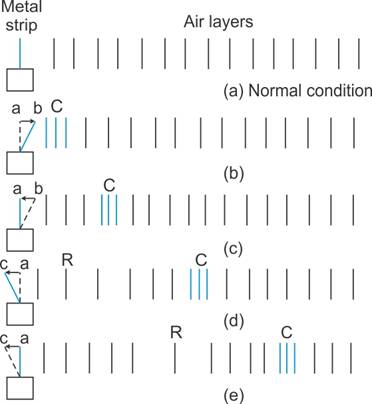
Solution C.3
A longitudinal wave propagates by means of compressions and rarefactions.
When a vibrating object moves forward, it pushes and compresses the air in front of it creating a region of high pressure. This region is called a compression (C), as shown in Fig. This compression starts to move away from the vibrating object. When the vibrating object moves backwards, it creates a region of low pressure called rarefaction (R), as shown in Fig.
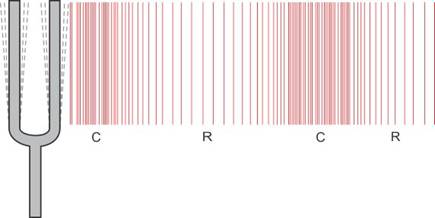
Compressions are the regions of high density where the particles of the medium come very close to each other and rarefactions are the regions of low density where the particles of the medium move away from each other.
Solution C.4
The number of vibrations made by the particle of the medium in one second is called the frequency of the wave. It can also be defined as the number of waves passing through a point in one second.
Its SI unit is hertz (Hz).
Solution C.5
The distance travelled by a wave in one second is called its wave velocity.
Its SI unit is metre per second (ms-1).
Solution C.6
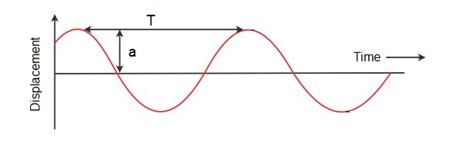
Solution C.7

Solution C.8
The speed of sound in a medium depends upon its elasticity and density.
Solution C.9
1 : 4 : 15
Solution C.10
Sound travels in iron faster than in air so first the sound travelled in iron rail is heard and then the sound travelled in air is heard.
Solution C.11
(i) The diver would hear the sound first.
(ii) This is because sound travels faster in water than in air.
(iii) It would take 0.25t to reach the diver because sound travels almost four times faster in water.
Solution C.12
(i) Speed of sound does not change with a change in amplitude.
(ii) Speed of sound does not change with a change in wavelength.
Solution C.13
Speed of sound is more in humid air because in presence of moisture, the density of air decreases and sound travels with greater speed.
![]()
Solution D.1(a)
Sound is a form of energy that produces the sensation of hearing in our ears. Sound is produced by a vibrating body.
Solution D.1(b)
Experiment: A tuning fork is taken and its one arm is struck on a rubber pad and it is brought near a tennis ball suspended by a thread as shown in figure.
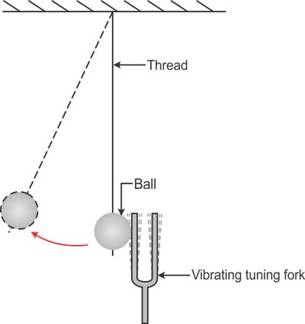
It is noticed that as the arm of the vibrating fork is brought close to the ball, it jumps back and forth and sound of the vibrating tuning fork is heard. When its arm stop vibrating, the ball becomes stationary and no sound is heard.
Solution D.2
Experiment to demonstrate that a material medium is necessary for the propagation of sound:
An electric bell is suspended inside an airtight glass bell jar. The bell jar is connected to a vacuum pump as shown in figure. As the circuit of electric bell is completed by pressing the key, the hammer of the electric bell begins to strike the gong repeatedly due to which sound is heard.
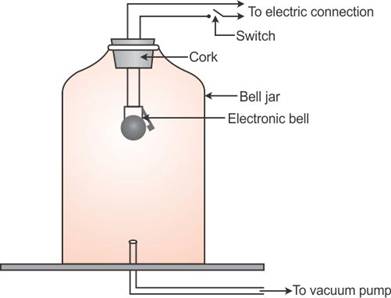
Keeping the key pressed, air is gradually withdrawn from jar by starting the vacuum pump. It is noticed that the loudness of sound goes on decreasing as the air is taken out from the bell jar and finally no sound is heard when all the air from the jar has been drawn out. The hammer of the electric bell is still seen striking the gong repeatedly which means that sound is still produced but it is not heard.
When the jar is filled with air, the vibrations produced by the gong are carried by the air to the walls of jar which in turn set the air outside the jar in vibration and sound is heard by us but in absence of air, sound produced by bell could not travel to the wall of the jar and thus no sound is heard. It proves that material medium is necessary for the propagation of sound waves.
Solution D.3
Experiment to show that in a wave motion, only energy is transferred, but particles of the medium do not move:
If we drop a piece of stone in the still water of pond, we hear a sound of stone striking the water surface. Actually a disturbance is produced in water at the point where the stone strikes it. This disturbance spreads in all directions radially outwards in form of circular waves on the surface of water.
If we place a piece of cork on water surface at some distance away from the point where the stone strikes it, we notice that cork does not move ahead, but it vibrates up and down, while the wave moves ahead. The reason is that particles of water (or medium) start vibrating up and down at the point where the stone strikes. These particles then transfer their energy to the neighboring particles and they themselves come back to their mean positions. Thus only energy is transferred but the particles of the medium do not move.
Solution D.4
(i) Frequency of sound has no effect on the speed of sound.
(ii) Speed of sound increases with the increase in the temperature of sound.
(iii) Pressure of sound has no effect on the speed of sound.
(iv) Speed of sound increases with the increase in presence of moisture in air.
Solution D.5
Let the velocity of a wave be V, time period T, frequency ![]() and wavelength
and wavelength![]() . By the definition of wavelength,
. By the definition of wavelength,
Wavelength = Distance travelled by the wave in one time period i.e., in T second
Or, wavelength = Wave velocity x Time period
Or, ![]() = V x T
= V x T
Or, ![]() = V x 1/
= V x 1/ ![]() [As, T = 1/]
[As, T = 1/]
Therefore, V = ![]()
![]()
Therefore, Wave velocity = Frequency x wavelength
Solution D.6
The simple experiment that a person can do to calculate the speed of sound in air is that a person stands at a known distance (d meter) from the cliff and fires a pistol and simultaneously start the stopwatch. He stops the stopwatch as soon as he hears an echo. The distance travelled by the sound during the time (t) seconds is 2d. So, speed of sound = distance travelled / time taken = 2d/t
The approximation made is that speed of sound remains same for the time when the experiment is taking place.
Solution E.1
Given, heart beats 75 times a minute
(a) Frequency = No. of times heart beats in 1 s
Or, ![]() = 75/60 = 1.25 s-1
= 75/60 = 1.25 s-1
(b) Time period, T = 1/ ![]()
Or, T = 1 / 1.25 = 0.8 s
Solution E.2
Frequency, ![]() = 1/T
= 1/T
Or, ![]() = 1/ 2 = 0.5 Hz
= 1/ 2 = 0.5 Hz
Solution E.3
Given, wavelength = 100m
Wave velocity = 20 m/s
We know that,
Wave velocity = Frequency x Wavelength
Or, Frequency = Wave velocity / wavelength
Or, ![]() = 20/100 = 0.2 Hz
= 20/100 = 0.2 Hz
Solution E.4
Wave velocity = 0.3 m/s
Frequency = 20 Hz
Separation between two consecutive compressions is the wavelength of a wave.
We know that,
Wave velocity = Frequency x Wavelength
Or, wavelength = Wave velocity / frequency
Or, ![]() = 0.3 / 20 = 1.5 x 10-2 m
= 0.3 / 20 = 1.5 x 10-2 m
Solution E.5
Frequency of wave = number of waves per second
Or, ![]() = 40 / 0.4 = 100 Hz
= 40 / 0.4 = 100 Hz
Solution E.6
Distance between the two observers = 1650 m
Speed of sound = 330 m/s
Time in which B hears the sound = Distance / speed = 1650/330 = 5s
Thus, B will hear the sound 5s after the gun is shot.
Solution E.7
Speed of sound in air (V) = 330 m/s
Time in which thunder is heard after lighting is seen (t) = 5s
Thus, distance between flash and observer = V x t = (330 x 5) = 1650 m
Solution E.8
Speed of sound in air (V) = 340 m/s
Time in which sound of fire is heard after flash is seen (t) = 2.5s
Thus, distance between flash and observer = V x t = (340 x 2.5) = 850 m
Solution E.9
Time taken by the observer to hear the sound of the first tank A= 3.5s
Time taken by the observer to hear the sound of the second tank B = 2s
Time taken by the tank B to hear the sound of tank A= (3.5 - 2)s = 1.5s
Distance between the two tanks = 510m
Speed = 510/1.5=340m/s
Solution E.10
(a) Length of iron rail (D) = 3.3 km = 3300 m
Speed of sound in iron (V) = 5280 m/s
Time taken by sound to travel in iron rod (t) = D/V
Or, t = (3300 / 5280) s = 0.625 s
(b) Length of iron rail (D) = 3.3 km = 3300 m
Speed of sound in air (V) = 330 m/s
Time taken by sound to travel in iron rod (t) = D/V
Or, t = (3300/330) s = 10 s
Solution E.11
(i) Distance travelled (D) = 1700
Speed of sound in air (V) = 340 m/s
Time taken (t) = D/V = (1700 / 340) s = 5 s
(ii) Distance travelled (D) = 1700
Speed of sound in water (V’) = 1360 m/s
Time taken (t) = D/V = (1700 / 1360) s = 1.25 s
Propagation of Sound Waves Exercise Ex 8(B)
Solution A.1
(c) 20 Hz - 20 kHz
The audible frequency range of sound is 20 Hz - 20 kHz.
Solution A.2
(b) 1000 Hz
Solution A.3
(c) 2000 Hz - 3000 Hz
Solution A.4
(a) the same as audible sound
Solution A.5
(c) heart
Echo-cardiography is used to obtain the image of heart.
Solution A.6
(b) infrasonic
Solution A.7
(d) Bats
Solution A.8
(a) solids
Sonic and ultrasonic waves travel with the same speed.
Solution A.9
(b) infrasonic
The sound of frequency less than 20 Hz is infrasonic sound.
Solution A.10
(b) High power and good directivity
Solution A.11
(b) ultrasound
Solution B.1
The range of frequency within which the sound can be heard by a human being is called the audible range of frequency.
Solution B.2
The audible range of frequency for humans is 20 Hz to 20 kHz.
Solution B.3
Human ears are most sensitive for the range 2000 Hz to 3000 Hz.
Solution B.4
Ultrasonic has higher frequency.
Solution B.5
(a) 20 Hz, 20 kHz (b) above 20 kHz (c) below 20 Hz (d) ultrasonic (e) infrasonic.
Solution B.6
(a) Infrasonic (b) Audible (c) Audible (d) Ultrasonic.
Solution B.7
Sounds of frequency above 20 kHz are called ultrasound.
Solution B.8
The approximate speed of ultrasound in air is 330 m/s-1.
Solution C.1
No, we cannot hear the sound produced due to vibrations of a seconds pendulum because the frequency of sound produced due to vibrations of seconds pendulum is 0.5 Hz which is infrasonic.
Solution C.2
Two properties of ultrasound which make it useful to us are:
(i) High energy contents
(ii) High directivity
Solution C.3
Two applications of ultrasound:
(i) Ultrasound is used for drilling holes or making cuts of desired shape in materials like glass.
(ii) Ultrasound is used in surgery to remove cataract and in kidneys to break the small stones into fine grains.
Solution D.1
|
Infrasonic |
Sonic |
Ultrasonic |
Supersonic |
|
It has frequency less than 20 Hz. |
It has the frequency equal to the audible frequency range (20 Hz to 20 kHz). |
It has the frequency greater than the audible frequency range (20kHz). |
The objects which travel with speed greater than the speed of sound in air (330 m/s) are supersonic. |
|
Examples: Elephants and whales can produce infrasonic sounds. |
Examples: Human beings can hear and speak in the frequency range of 20 Hz - 20 kHz |
Examples: Dolphins and bats produces ultrasonic sounds. |
Examples: Concord jet planes, fighter planes |
Solution D.2
Bats locate the obstacles and prey in their path by producing and hearing the ultrasound. They emit an ultrasound which returns after striking an obstacle in their way. By hearing the reflected sound and from the time interval (when they produce ultrasound and they receive them back), they can judge the direction and the distance of the obstacle in their way.
